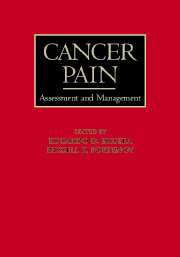Book contents
- Frontmatter
- Contents
- List of contributors
- Preface
- SECTION I MECHANISMS AND EPIDEMIOLOGY
- SECTION II ASSESSMENT AND SYNDROMES
- SECTION III PHARMACOLOGICAL TREATMENT
- SECTION IV NONPHARMACOLOGICAL APPROACHES
- SECTION V THE ROLE OF ANTINEOPLASTIC THERAPIES IN PAIN CONTROL
- SECTION VI PAIN IN SPECIAL POPULATIONS
- 18 Cancer pain management in the chemically dependent patient
- 19 Cancer pain in children
- 20 Cancer pain in the elderly
- SECTION VII DIFFICULT PAIN PROBLEMS
- SECTION VIII SPECIAL TOPICS
- Index
19 - Cancer pain in children
from SECTION VI - PAIN IN SPECIAL POPULATIONS
Published online by Cambridge University Press: 08 October 2009
- Frontmatter
- Contents
- List of contributors
- Preface
- SECTION I MECHANISMS AND EPIDEMIOLOGY
- SECTION II ASSESSMENT AND SYNDROMES
- SECTION III PHARMACOLOGICAL TREATMENT
- SECTION IV NONPHARMACOLOGICAL APPROACHES
- SECTION V THE ROLE OF ANTINEOPLASTIC THERAPIES IN PAIN CONTROL
- SECTION VI PAIN IN SPECIAL POPULATIONS
- 18 Cancer pain management in the chemically dependent patient
- 19 Cancer pain in children
- 20 Cancer pain in the elderly
- SECTION VII DIFFICULT PAIN PROBLEMS
- SECTION VIII SPECIAL TOPICS
- Index
Summary
Introduction
In their experience of illness related to cancer or its treatment, children and their families report that pain is one of the most feared symptoms. Fortunately, the majority of children can achieve adequate analgesia if current pain management techniques are used. It is the rare pediatric patient who develops intractable pain. The World Health Organization (WHO) has established the principles of pain management and palliative care as a universal standard of care for all children with cancer. Cancer Pain Relief and Palliative Care in Children (1) is a guideline that contains information on the assessment of pain in children, analgesics and adjuvant analgesics, and the principles of non-pharmacological methods of pain control in children undergoing painful procedures (1). Recent data suggest there is room for improvement in pain management for children with cancer (2).
Epidemiology of cancer pain in children
Pain is a common symptom experienced by children with cancer. A cohort of 149 British and Australian children with cancer 7 to 12 years old were surveyed about their experience of symptoms during the preceding 48 hours (3). Approximately one third had experienced pain in the previous 48 hours. Over half of this group had pain in the medium to severe range, and one third were highly distressed by their experience (3).
As part of the validation study of Memorial Symptom Assessment Scale 10–18 (4) (MSAS 10–18), information was acquired about symptom characteristics from a heterogeneous population of children with cancer ages 10 to 18 years at Memorial Sloan-Kettering Cancer Center, New York. Children were asked about their symptoms during the preceding week.
- Type
- Chapter
- Information
- Cancer PainAssessment and Management, pp. 343 - 353Publisher: Cambridge University PressPrint publication year: 2003



